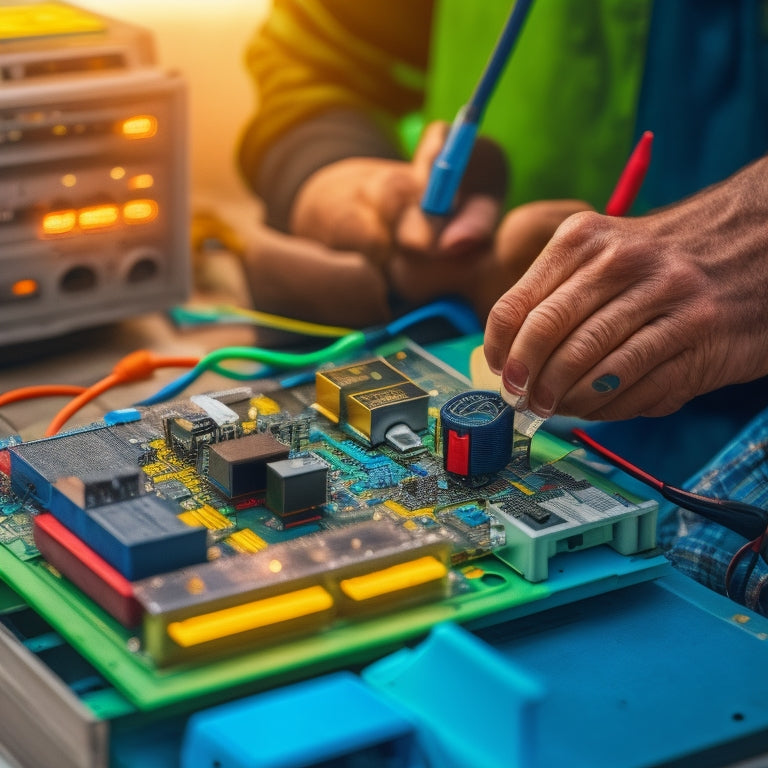
5 Essential Battery Maintenance Tips
Share
You can greatly extend the lifespan of your batteries by following a few simple maintenance routines. Check your battery's water levels regularly to prevent damage from overfilling or dryness, and verify the water level remains between the minimum and maximum marks. Monitor charge cycles and depth to avoid excessive deep discharging, which reduces overall lifespan. Clean terminals and connections to prevent corrosion and voltage drops. Store your batteries in cool, dry places to slow down chemical reactions. Finally, perform regular capacity tests to identify potential issues early. By following these essential tips, you'll be well on your way to maximizing your battery's performance and lifespan - and there's more to investigate in your expedition to battery maintenance expertise.
Overview
- Check water levels monthly, maintaining levels between minimum and maximum marks, and top off with distilled water to prevent damage.
- Monitor charge cycles and depth of discharge to maximize lifespan, aiming for 20% to 80% discharge to prevent excessive wear.
- Clean terminals and connections regularly with a wire brush, baking soda, and water to prevent corrosion and performance decrease.
- Store batteries in cool, dry places (60°F to 80°F) to slow down chemical reactions and prolong lifespan.
- Perform regular capacity tests, including state of charge, voltage, and internal resistance checks, to identify potential issues early.
Check Battery Water Levels Regularly
You should make it a habit to regularly check your battery's water levels to guarantee peak performance and longevity.
Regular monitoring of battery state of charge (SOC) and depth of discharge (DOD) prevents overcharging and undercharging Battery Monitoring and Maintenance.
For flooded battery types, which have removable caps, you'll need to inspect the water level monthly. Confirm the water level is between the recommended minimum and maximum marks.
If the level is low, top it off with distilled water, avoiding tap water due to its poor water quality. Never overfill, as this can cause damage.
For maintenance-free battery types, such as sealed or gel batteries, you won't need to check water levels, but it's still essential to monitor their overall condition.
Monitor Charge Cycles and Depth
Its charge cycle count and depth of discharge (DOD) greatly impact a battery's lifespan and overall health. You should regularly monitor these metrics to guarantee peak performance and extend your battery's lifespan.
Keep an eye on charge indicators, such as voltage and state-of-charge readings, to determine when your battery is fully charged or deeply discharged. Regular review of charge cycles can identify potential issues early smart charging systems, and prevent overcharging/undercharging to maximize battery lifespan.
Aim to keep your DOD between 20% and 80% to maximize your cycle lifespan. Excessive deep discharging can considerably reduce your battery's overall lifespan.
Clean Terminals and Connections
Corrosion at the terminals and connections can silently sabotage your battery's performance, so it's vital to clean them regularly.
Terminal corrosion can lead to voltage drops, increased internal resistance, and decreased overall efficiency. Regular water level checks and cleaning of terminals are necessary to prevent electrical resistance and heat buildup.
You'll need a wire brush, baking soda, and water to clean the terminals. Gently brush away any visible corrosion, then mix baking soda and water to create a paste.
Apply the paste to the terminals and connections, letting it sit for a few minutes before rinsing with water. Dry the terminals thoroughly to prevent further corrosion.
Store Batteries in Cool Dry Places
Most batteries are sensitive to temperature extremes, and storing them in cool dry places can greatly prolong their lifespan.
You'll want to avoid storing batteries in areas prone to moisture, such as basements or attics, as this can lead to corrosion and reduce their overall performance.
Instead, opt for storage solutions like climate-controlled rooms or cabinets that maintain a consistent temperature between 60°F and 80°F (15°C and 27°C).
This will help slow down chemical reactions within the battery, resulting in a longer battery lifespan.
Perform Regular Capacity Tests
You should perform regular capacity tests on your batteries to identify any potential issues before they become major problems. This helps you stay on top of your battery's health and prevents unexpected failures. Capacity tests provide critical capacity indicators, such as the battery's state of charge, voltage, and capacity percentage.
| Testing Frequency | Capacity Indicators |
|---|---|
| Monthly | State of charge, voltage |
| Quarterly | Capacity percentage, cycle count |
| Semiannually | Internal resistance, temperature |
| Annually | Overall health, lifespan estimate |
| As Needed | Custom tests for specific issues |
Frequently Asked Questions
Can I Use Tap Water to Top off My Battery's Water Levels?
You shouldn't use tap water to top off your battery's water levels, as it may contain minerals that can contaminate your battery, especially in maintenance-free or sealed battery types, requiring high water quality to guarantee maximum performance and longevity.
How Often Should I Equalize My Deep-Cycle Battery?
When you're boondocking in your RV for weeks, you'll want to equalize your deep-cycle battery every 10-15 charging cycles to prevent sulphation and maintain peak battery health, ensuring you stay off-grid without interruptions.
What Is the Ideal Storage Temperature for My Batteries?
You're storing your batteries in a spot with a consistent temperature between 40°F and 70°F (4°C and 21°C) to maximize battery lifespan, as extreme storage conditions can cause damage and reduce overall performance.
Can I Use a Car Charger to Charge My Deep-Cycle Battery?
You're burning the midnight oil, wondering if a car charger can charge your deep-cycle battery. The answer is, it's not a one-size-fits-all solution; car chargers are designed for starting batteries, not deep-cycle batteries, so you'll need a charger customized to your battery type's specific charging methods.
How Do I Know if My Battery Is Still Under Warranty?
You'll know if your battery's under warranty by checking the manufacturer's warranty duration, usually listed on the label or website, and looking for battery indicators like a warranty sticker or a date code on the battery itself.
Ready to Buy
As you follow these essential battery maintenance tips, think of your batteries as delicate instruments, requiring fine-tuning to perform in harmony. By regularly checking water levels, monitoring charge cycles, cleaning terminals, storing them in cool dry places, and performing capacity tests, you'll be orchestrating a concert of efficiency and longevity. With these habits, your batteries will hum along smoothly, providing reliable power and avoiding costly replacements.
Related Posts
-

What Do I Need to Know About Farm Solar Panels
When considering farm solar panels, you need to assess costs, benefits, and technical specifics. Initial investment c...
-

Why Outdoor Solar Lighting Systems Are Sustainable
Outdoor solar lighting systems are sustainable because they utilize renewable energy, drastically reducing your carbo...
-

Essential Solar Panel Mounts for Commercial Properties
When it comes to essential solar panel mounts for your commercial property, durability and wind resistance are key fa...


